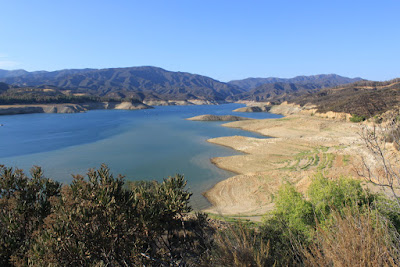 |
| Lush waters of Los Angeles' Arroyo Seco or "Dry Gulch" (pasadenaweekly.com) |
 |
| Climate chaos: Rain, mudslides from dramatic storms in Pacific Northwest 2015 (AP) |
 |
| Almaden Reservoir is filled after series of storms, March 14, 2016, in San Jose, NoCal: Four straight days of rain have replenished key reservoirs in drought-stricken California (AP). |
.
Did we have a natural drought?
Wisdom Quarterly (COMMENTARY)
 |
| California reservoir levels March 13, 2016 |
Nature is doing its part, and government is dropping the ball. More than the amount of water needed to declare the drought over (measured in a specific number of gallons) is sitting in California's Lake Tahoe and could be moved where it's needed.
Water from the Pacific Ocean could be desalinated. But, but...! People parrot naysayers in the mainstream media about cost or convenience or nonsense based on not understanding the technology, which works just fine on an industrial scale in Israel.
There is no imminent "shortage" of water just a human certainty of prices for it going up -- and for that a "drought" is needed with austerity measures, continued chemtrail spraying (now admitted by the government after years of silence poisoning population centers, soil, and waterways), enforced conservation, and hefty fines.
- UPDATE: Some NorCal reservoirs at flood stage, SoCal lagging
 (SCPR) Storms over the weekend pushed an important water
supply reservoir in Northern California to above average capacity for
the first time in years.
(SCPR) Storms over the weekend pushed an important water
supply reservoir in Northern California to above average capacity for
the first time in years.
Water levels at Lake Shasta are now 103 percent of their historic
capacity. Despite a storm here Friday, Southern California hasn't seen
anywhere near the same kind of rain this winter, and local reservoirs
remain low.
Reservoirs like [Los Angeles adjacent] Castaic Lake [pictured above] and Lake Perris are only about 40 percent of their historical average, according to the state Department of Water Resources. More
Storms replenish key reservoirs
 |
| Brideveil Falls, Yosemite, may come back. |
The series of storms that started late last week drenched the state, closing roads and schools while causing flooding and power outages. Northern California was the hardest hit over four days. Other parts of the state saw the heaviest rainfall late last week.
 |
| CA meets target 3rd month |
As the latest storm weakened, warm temperatures and blue skies were forecast throughout California during the rest of the week. The El Nino-related storms led to the death Sunday of a highway patrol officer who was struck while directing traffic on a snowy Sierra Nevada freeway.
 |
| RAIN: Mud covers highways and strands drivers in Southern California |
Full reservoirs and a lush snowpack in Northern California are critical for the entire state as the water eventually flows to the agriculture-rich Central Valley and densely populated Southern California, which has seen relatively little rain this winter.
In Northern California, officials reported that lakes Shasta and Oroville have not been as full since 2013. Lake Shasta, the state's largest reservoir, was at 79 percent capacity and at 103 percent of its historical average for this time of year.
 |
| Strongest El Nino storm so far |
For example, man-made New Melones in the Sierra Nevada foothills remains at just 22 percent of capacity and well below the historical average. The state's second-largest reservoir, Lake Oroville, was at 70 percent of capacity and hit its historical average Monday. Folsom Lake, 25 miles northeast of Sacramento, was at 69 percent of capacity.
 |
| El Nino could ease drought |
California Governor Jerry Brown ordered mandatory cutbacks of 25 percent in water use last year. George Kostyrko, spokesman for the State Water Resources Control Board, said the panel will reconsider restrictions in May.
"March is really looking good so far and we're hoping for an awesome April, but we can't revisit our regulations until the end of the water year, which is April," he said. Heavy snow fell throughout the weekend in the Sierra Nevada... More





















































































































































































































































No comments:
Post a Comment